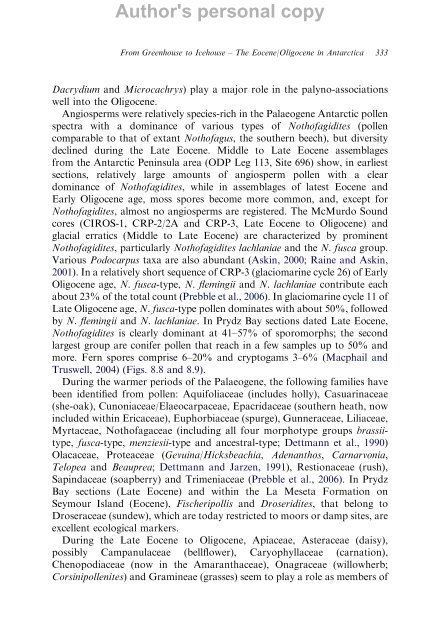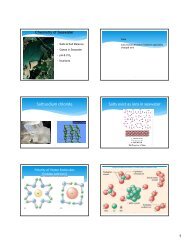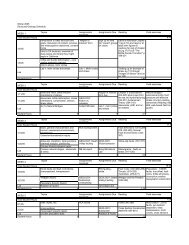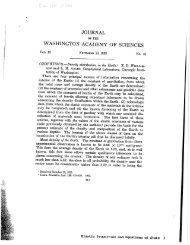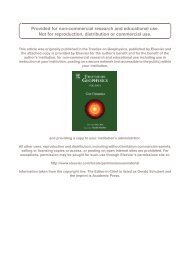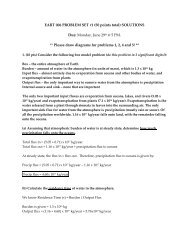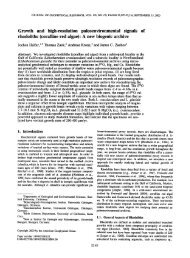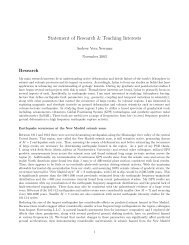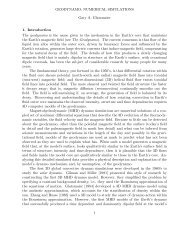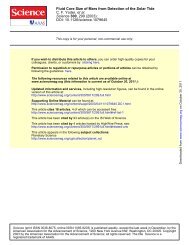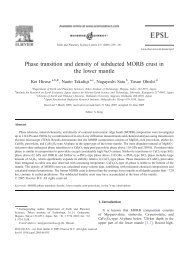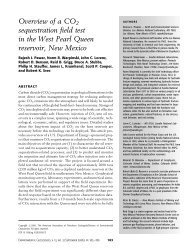From Greenhouse to Icehouse – The Eocene/Oligocene - UMass ...
From Greenhouse to Icehouse – The Eocene/Oligocene - UMass ...
From Greenhouse to Icehouse – The Eocene/Oligocene - UMass ...
You also want an ePaper? Increase the reach of your titles
YUMPU automatically turns print PDFs into web optimized ePapers that Google loves.
Author's personal copy<br />
<strong>From</strong> <strong>Greenhouse</strong> <strong>to</strong> <strong>Icehouse</strong> <strong>–</strong> <strong>The</strong> <strong>Eocene</strong>/<strong>Oligocene</strong> in Antarctica 333<br />
Dacrydium and Microcachrys) play a major role in the palyno-associations<br />
well in<strong>to</strong> the <strong>Oligocene</strong>.<br />
Angiosperms were relatively species-rich in the Palaeogene Antarctic pollen<br />
spectra with a dominance of various types of Nothofagidites (pollen<br />
comparable <strong>to</strong> that of extant Nothofagus, the southern beech), but diversity<br />
declined during the Late <strong>Eocene</strong>. Middle <strong>to</strong> Late <strong>Eocene</strong> assemblages<br />
from the Antarctic Peninsula area (ODP Leg 113, Site 696) show, in earliest<br />
sections, relatively large amounts of angiosperm pollen with a clear<br />
dominance of Nothofagidites, while in assemblages of latest <strong>Eocene</strong> and<br />
Early <strong>Oligocene</strong> age, moss spores become more common, and, except for<br />
Nothofagidites, almost no angiosperms are registered. <strong>The</strong> McMurdo Sound<br />
cores (CIROS-1, CRP-2/2A and CRP-3, Late <strong>Eocene</strong> <strong>to</strong> <strong>Oligocene</strong>) and<br />
glacial erratics (Middle <strong>to</strong> Late <strong>Eocene</strong>) are characterized by prominent<br />
Nothofagidites, particularlyNothofagidites lachlaniae and the N. fusca group.<br />
Various Podocarpus taxa are also abundant (Askin, 2000; Raine and Askin,<br />
2001). In a relatively short sequence of CRP-3 (glaciomarine cycle 26) of Early<br />
<strong>Oligocene</strong> age, N. fusca-type, N. flemingii and N. lachlaniae contribute each<br />
about 23% of the <strong>to</strong>tal count (Prebble et al., 2006). In glaciomarine cycle 11 of<br />
Late <strong>Oligocene</strong> age, N. fusca-type pollen dominates with about 50%, followed<br />
by N. flemingii and N. lachlaniae. In Prydz Bay sections dated Late <strong>Eocene</strong>,<br />
Nothofagidites is clearly dominant at 41<strong>–</strong>57% of sporomorphs; the second<br />
largest group are conifer pollen that reach in a few samples up <strong>to</strong> 50% and<br />
more. Fern spores comprise 6<strong>–</strong>20% and cryp<strong>to</strong>gams 3<strong>–</strong>6% (Macphail and<br />
Truswell, 2004) (Figs. 8.8 and 8.9).<br />
During the warmer periods of the Palaeogene, the following families have<br />
been identified from pollen: Aquifoliaceae (includes holly), Casuarinaceae<br />
(she-oak), Cunoniaceae/Elaeocarpaceae, Epacridaceae (southern heath, now<br />
included within Ericaceae), Euphorbiaceae (spurge), Gunneraceae, Liliaceae,<br />
Myrtaceae, Nothofagaceae (including all four morphotype groups brassiitype,<br />
fusca-type, menziesii-type and ancestral-type; Dettmann et al., 1990)<br />
Olacaceae, Proteaceae (Gevuina/Hicksbeachia, Adenanthos, Carnarvonia,<br />
Telopea and Beauprea; Dettmann and Jarzen, 1991), Restionaceae (rush),<br />
Sapindaceae (soapberry) and Trimeniaceae (Prebble et al., 2006). In Prydz<br />
Bay sections (Late <strong>Eocene</strong>) and within the La Meseta Formation on<br />
Seymour Island (<strong>Eocene</strong>), Fischeripollis and Droseridites, that belong <strong>to</strong><br />
Droseraceae (sundew), which are <strong>to</strong>day restricted <strong>to</strong> moors or damp sites, are<br />
excellent ecological markers.<br />
During the Late <strong>Eocene</strong> <strong>to</strong> <strong>Oligocene</strong>, Apiaceae, Asteraceae (daisy),<br />
possibly Campanulaceae (bellflower), Caryophyllaceae (carnation),<br />
Chenopodiaceae (now in the Amaranthaceae), Onagraceae (willowherb;<br />
Corsinipollenites) and Gramineae (grasses) seem <strong>to</strong> play a role as members of


